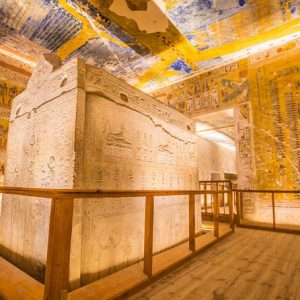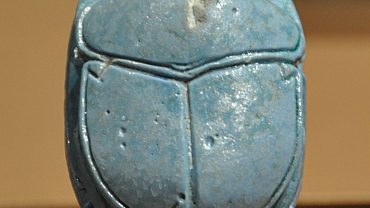The Old Kingdom
The 4th dynasty (c. 2575–c. 2465 BCE)
The first king of the 4th dynasty, Snefru, probably built the step pyramid of Maydūm and then modified it to form the first true pyramid. Due west of Maydūm was the small step pyramid of Saylah, in Al-Fayyūm, at which Snefru also worked. He built two pyramids at Dahshūr; the southern of the two is known as the Blunted Pyramid because its upper part has a shallower angle of inclination than its lower part. This difference may be due to structural problems or may have been planned from the start, in which case the resulting profile may reproduce a solar symbol of creation. The northern Dahshūr pyramid, the later of the two, has the same angle of inclination as the upper part of the Blunted Pyramid and a base area exceeded only by that of the Great Pyramid at Giza. All three of Snefru’s pyramids had mortuary complexes attached to them. Snefru’s building achievements were thus at least as great as those of any later king and introduced a century of unparalleled construction.
In a long perspective, the 4th dynasty was an isolated phenomenon, a period when the potential of centralization was realized to its utmost and a disproportionate amount of the state’s resources was used on the kings’ mortuary provisions, almost certainly at the expense of general living standards. No significant 4th-dynasty sites have been found away from the Memphite area. Tomb inscriptions show that high officials were granted estates scattered over many nomes, especially in the delta. This pattern of landholding may have avoided the formation of local centres of influence while encouraging intensive exploitation of the land. People who worked on these estates were not free to move, and they paid a high proportion of their earnings in dues and taxes. The building enterprises must have relied on drafting vast numbers of men, probably after the harvest had been gathered in the early summer and during part of the inundation.
Snefru’s was the first king’s name that was regularly written inside the cartouche, an elongated oval that is one of the most characteristic Egyptian symbols. The cartouche itself is older and was shown as a gift bestowed by gods on the king, signifying long duration on the throne. It soon acquired associations with the sun, so that its first use by the builder of the first true pyramid, which is probably also a solar symbol, is not coincidental.
The 5th dynasty (c. 2465–c. 2325 BCE)
The first two kings of the 5th dynasty, Userkaf and Sahure, were sons of Khentkaues, who was a member of the 4th-dynasty royal family. The third king, Neferirkare, may also have been her son. A story from the Middle Kingdom that makes them all sons of a priest of Re may derive from a tradition that they were true worshipers of the sun god and implies, probably falsely, that the 4th-dynasty kings were not. Six kings of the 5th dynasty displayed their devotion to the sun god by building personal temples to his cult. These temples, of which the two so far identified are sited similarly to pyramids, probably had a mortuary significance for the king as well as honouring the god. The kings’ pyramids should therefore be seen in conjunction with the sun temples, some of which received lavish endowments and were served by many high-ranking officials.
Pyramids have been identified for seven of the nine kings of the dynasty, at Ṣaqqārah (Userkaf and Unas, the last king), Abū Ṣīr (Sahure, Neferirkare, Reneferef, and Neuserre), and south Ṣaqqārah (Djedkare Izezi, the eighth king). The pyramids are smaller and less solidly constructed than those of the 4th dynasty, but the reliefs from their mortuary temples are better preserved and of very fine quality; that of Sahure gives a fair impression of their decorative program. The interiors contained religious scenes relating to provision for Sahure in the next life, while the exteriors presented his “historical” role and relations with the gods. Sea expeditions to Lebanon to acquire timber are depicted, as are aggression against and capture of Libyans. Despite the apparent precision with which captives are named and total figures given, these scenes may not refer to specific events, for the same motifs with the same details were frequently shown over the next 250 years; Sahure’s use of them might not have been the earliest.



Commentaire (0)